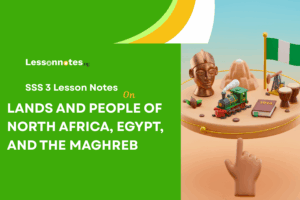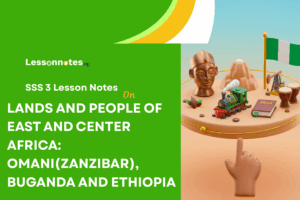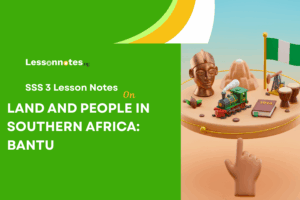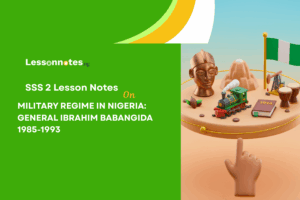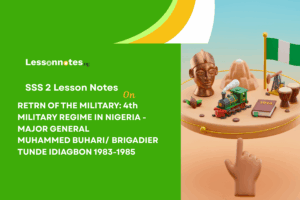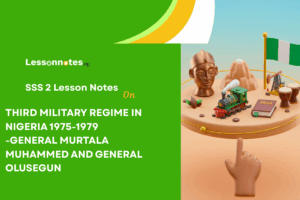IGALA UP TO 1800 SS1 Nigerian History Lesson Note
Download Lesson NoteTopic: IGALA UP TO 1800
The Igala Kingdom was one of the important states that existed in what is now central Nigeria before the modern era. Located along the eastern banks of the River Niger and around the Benue River, the Igala people built a strong kingdom with unique political, social, and economic systems. This lesson explores the origins of the Igala Kingdom, how it was governed, its economy, culture, and its relationships with neighboring states up to the year 1800.
Origin and Location of the Igala Kingdom
Geographic Location
The Igala Kingdom occupied a strategic position:
- Located at the confluence of the Niger and Benue Rivers
- Mostly on the eastern side of the River Niger
- Extended across parts of what is now Kogi State, Nigeria
- Bordered by the Nupe to the north
- The Igbo to the east and southeast
- The Yoruba to the southwest
- The Idoma and Bassa to the northeast
- Covered approximately 13,665 square kilometers of land
- The terrain included riverbanks, fertile plains, and woodland
Origin of the Igala People
Several traditions explain Igala origins:
- One tradition traces Igala ancestry to Yoruba origins
- Another links them to the Jukun of the Kwararafa Empire
- Some believe they have connections to the Benin Kingdom
- Others suggest they developed independently in their location
- Archaeological evidence shows settlement in the area for centuries
- The name “Igala” refers to both the people and their language
- They likely emerged as a distinct group around the 14th century
- Gradually unified from smaller communities into one kingdom
- Cultural practices show influences from several neighboring groups
Foundation of the Kingdom
The Igala Kingdom was established through various processes:
- Most accounts credit Abutu-Eje as the first divine king (Attah)
- Said to have come from Yorubaland or the Jukun Kingdom
- Unified previously separate Igala communities
- Established the royal dynasty that would rule Igala
- Created the capital at Idah (also spelled Ida)
- Introduced the sacred kingship institution
- Set up a centralized government structure
- The kingdom likely consolidated in the 16th century
- Expanded through conquest and alliance
- Incorporated various ethnic groups under Igala rule
Political Organization of the Igala Kingdom
The Attah Igala
The king was at the center of government:
- Called the “Attah Igala” (meaning “Father of Igala”)
- Considered divine and semi-divine
- Wore special regalia including beaded crown and staff
- Lived in an elaborate palace at Idah
- Served as the supreme political, judicial, and religious leader
- Could not be seen eating or drinking in public
- Had numerous wives who played administrative roles
- Required elaborate rituals and protocols
- When an Attah died, a complex succession process began
- The position passed through royal lineages
The Council of Chiefs
The Attah was supported by important chiefs:
- Nine principal chiefs known as the “Igala Mela”
- Divided into two groups: the Amomā and the Ihobe
- The Onu Ọja served as prime minister
- The Achadu was the heir-apparent and chief judge
- The Agbanya handled security matters
- The Ọchai, Ọkwulā, and Ọdoma were military leaders
- Ejeh chiefs administered provinces
- These chiefs advised the Attah on important matters
- Some positions were hereditary within certain clans
- The council balanced the Attah’s power
Territorial Administration
The kingdom was divided for effective governance:
- Districts called “Ane” headed by district chiefs
- Villages governed by village heads known as “Onu Ọgbē”
- Family compounds led by family heads
- The clan system helped organize communities
- Province chiefs reported to the central government
- Tax collectors worked throughout the territory
- Messengers carried the Attah’s orders to distant areas
- Local courts handled disputes at the district level
- Important cases went to the Attah’s court
- This system allowed control of a large territory
Military Organization
The Igala developed an effective military:
- War chiefs led different sections of the army
- Infantry using bows, arrows, spears, and shields
- Some cavalry (horsemen) for rapid movement
- River forces using canoes for water battles
- Warriors organized by age grades and clans
- Military training for young men
- Defensive walls around important settlements
- Fortresses at strategic locations
- War drums and horns for communication
- Success in battle brought prestige and captives
Justice System
Law and order was maintained through:
- Traditional laws based on customs and precedents
- The Attah served as the final court of appeal
- Chiefs judged cases at different levels
- Family heads resolved domestic disputes
- Clan leaders handled conflicts within clans
- Serious crimes like murder had severe punishments
- Compensation required for many offenses
- Oath-taking to determine guilt or innocence
- Trials sometimes used supernatural tests
- Justice reinforced social harmony
Economy of the Igala Kingdom
Strategic River Location
The rivers were central to Igala prosperity:
- Located at the confluence of Niger and Benue Rivers
- These rivers served as natural highways for trade
- Control of river crossing points brought wealth
- Fishing was productive in the rivers
- Canoes and boats allowed transportation and trade
- Fertile soil along riverbanks supported farming
- Rivers connected Igala to distant market networks
- River ports became centers of economic activity
- Floods brought nutrients to farmland annually
- This location gave Igala significant advantages
Agriculture
Farming was the foundation of the economy:
- Yams were the most important crop
- Also grew guinea corn, millet, and vegetables
- Palm oil and palm wine production
- Kept livestock including goats, sheep, and chickens
- Practiced crop rotation for soil fertility
- Used simple tools like hoes and digging sticks
- Farming was organized by families and age groups
- Agricultural surplus supported crafts and trade
- Seasonal planting followed the rainfall pattern
- Communal labor helped with large farming tasks
Trade and Commerce
The Igala were active traders:
- Controlled important trade routes along the rivers
- Market towns developed at river crossings
- Traded with Nupe, Igbo, Idoma, and Yoruba peoples
- Exported crafts, agricultural products, and fish
- Imported salt, metals, beads, and luxury goods
- Used cowrie shells as currency
- Market days operated on regular schedules
- Long-distance traders formed associations
- Women dominated local market trade
- Trade brought wealth and outside influences
Crafts and Industries
Specialized production was well-developed:
- Blacksmithing for tools and weapons
- Pottery making, especially by women
- Woodcarving for masks, stools, and utensils
- Weaving of cotton textiles
- Basket making using river reeds
- Leather working for various items
- Canoe building for river transportation
- Brass casting learned from Benin artisans
- Beadwork for royal regalia
- These crafts supported both local needs and trade
Fishing and Hunting
Water and forest resources were important:
- Fishing in the rivers using nets and traps
- Fish were eaten fresh or dried for preservation
- Hunting for bushmeat in the forests
- Specialized fishing and hunting groups
- Used dogs for hunting
- Trapping of smaller animals
- Hunting rituals and customs
- Meat and fish provided protein in the diet
- Surplus was traded to inland communities
- Environmental knowledge passed through generations
Social Organization and Culture
Clan System
Igala society was organized through clans:
- Belonged to patrilineal clans called “Ebo”
- Clans traced descent to common ancestors
- Clan members had specific responsibilities
- Could not marry within the same clan
- Some clans had specific craft specializations
- Others had ritual or political roles
- Clan elders made important decisions
- Land was often owned by clans, not individuals
- Clan identity was a core part of personal identity
- Provided support networks across the kingdom
Age Grade System
Age groups helped organize community life:
- Boys and girls initiated into age groups together
- Moved through life stages as a cohort
- Young men’s groups provided labor and defense
- Young women’s groups had specific duties
- Elders had special status and authority
- Age grades organized community projects
- Enforced social norms and rules
- Created bonds across clan lines
- Helped integrate young people into adult society
- Provided structure for community governance
Religious Beliefs
Spiritual practices were important:
- Belief in a creator god called “Ọjọ”
- Veneration of ancestors (called “Ibegwu”)
- Nature spirits associated with rivers, forests, and land
- Rituals for planting, harvest, and other key times
- Sacred places throughout the territory
- Divination to understand supernatural will
- Medicine men and women with healing knowledge
- Masquerades representing spiritual forces
- The Attah served as the chief religious figure
- Religious beliefs unified society
Artistic Traditions
The Igala developed distinctive arts:
- Carved wooden masks for ceremonies
- Decorative doors and house posts
- Pottery with distinctive patterns
- Beadwork on royal items
- Body scarification as cultural markers
- Music using drums, flutes, and stringed instruments
- Dance traditions for different occasions
- Oral poetry and praise-singing
- Storytelling preserving history and values
- These arts expressed Igala identity
Relations with Neighboring States
Connections with Benin Kingdom
Igala had important ties to Benin:
- Cultural exchanges with the Benin Kingdom
- Some royal regalia similar to Benin styles
- Trading relationships along river routes
- Adopted some Benin artistic techniques
- Diplomatic relations between courts
- Some marriage alliances between royal families
- Competition for control of trade routes
- Both kingdoms influenced smaller communities between them
- Mutual respect between powerful states
- Cultural borrowing went both ways
Relations with Nupe
The Nupe were important neighbors:
- Sometimes allies, sometimes rivals
- Competed for control of river trade
- Shared some cultural and religious practices
- Trading partnerships between merchants
- Periodic border conflicts
- The legend of Tsoede connects Igala and Nupe
- Claims that Nupe royal dynasty came from Igala
- Military confrontations occurred occasionally
- Diplomatic efforts to maintain peace
- Marriage alliances between elite families
Influence on Smaller States
Igala dominated nearby groups:
- Collected tribute from smaller communities
- Cultural influence spread along trade routes
- Igala language adopted by some neighboring peoples
- Political institutions copied by smaller states
- Military protection offered in exchange for loyalty
- Controlled access to river trading networks
- Some groups voluntarily joined the Igala system
- Others were incorporated through conquest
- Created a sphere of influence beyond direct control
- Served as cultural and political model
European Contact
By the late 1700s, European influence began:
- European travelers described the Igala Kingdom
- Limited trade with European merchants
- Europeans impressed by the kingdom’s organization
- Early accounts mentioned the power of the Attah
- Some European goods reached Igala through trade
- Slave trade affected the region indirectly
- Igala remained independent of European control
- Kingdom maintained its traditional structures
- More intensive European contact would come later
- Knowledge of outside world increased
Notable Rulers and Events
Early Attah Igalas
The first rulers established the kingdom:
- Attah Abutu-Eje is considered the founder
- Established the royal dynasty
- Set up the basic structure of government
- Created the capital at Idah
- Expanded Igala territory
- Stories of his supernatural powers
- His descendants ruled as later Attahs
- Name is still honored in traditions
- Brought unity to previously separate communities
- Exact dates of reign are uncertain
Attah Ayegba (Circa Late 17th Century)
One of the most famous rulers:
- Expanded the kingdom’s territory
- Strengthened the military
- Had nine principal chiefs (Igala Mela)
- Associated with the famous “Inikpi sacrifice” story
- His daughter Inikpi supposedly sacrificed herself to save the kingdom
- Defended against external threats
- Reformed the administrative system
- Reinforced the power of the Attah
- His reign is remembered in oral traditions
- Considered one of the greatest Igala rulers
Attah Ekelaga
Made important contributions:
- Ruled in the mid-18th century
- Expanded trade networks
- Strengthened relations with neighboring states
- Developed Idah as an important center
- Reformed tax collection
- Supported craft production
- Built infrastructure including roads
- Maintained peace during his reign
- Appointed effective administrators
- Left the kingdom stronger at his death
By 1800, the Igala Kingdom had developed into a significant state in the area that is now central Nigeria. Its strategic location at the confluence of the Niger and Benue Rivers gave it advantages in trade, agriculture, and regional influence. The kingdom had a sophisticated political system centered on the divine king (Attah Igala) and supported by a complex hierarchy of chiefs and officials.
The Igala economy combined agriculture, fishing, crafts, and trade. Its control of river routes made it an important commercial center. Social organization through clans and age grades helped maintain order and unity. Rich cultural traditions in religion, art, and music expressed Igala identity and values.
Relations with neighboring states like Benin and Nupe involved both cooperation and competition. The Igala influenced smaller communities around them through both conquest and cultural example. By 1800, the kingdom was beginning to experience contact with Europeans, though it remained independent and true to its traditions.
The legacy of the pre-1800 Igala Kingdom can still be seen today in cultural practices, social structures, and historical memory among the Igala people of modern Nigeria. Understanding this historical kingdom helps us appreciate the complex and sophisticated political systems that existed in Africa before widespread European colonization.




